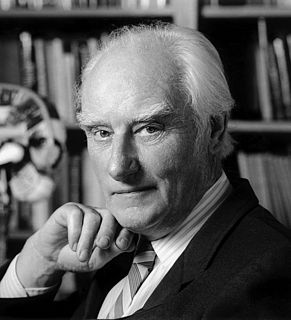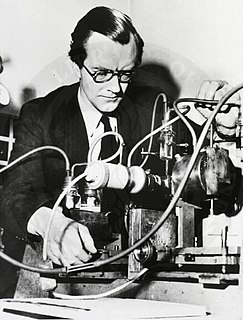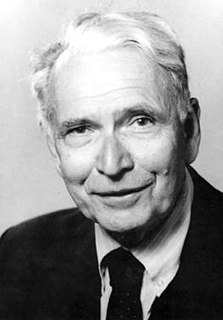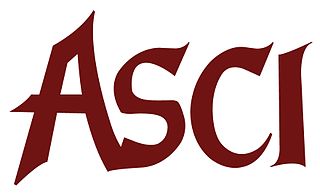
Francis Harry Compton Crick was a British molecular biologist, biophysicist, and neuroscientist. He, James Watson, and Rosalind Franklin played crucial roles in deciphering the helical structure of the DNA molecule. Crick and Watson's paper in Nature in 1953 laid the groundwork for understanding DNA structure and functions. Together with Maurice Wilkins, they were jointly awarded the 1962 Nobel Prize in Physiology or Medicine "for their discoveries concerning the molecular structure of nucleic acids and its significance for information transfer in living material".

James Dewey Watson KBE is an American molecular biologist, geneticist and zoologist. In 1953, he co-authored with Francis Crick the academic paper proposing the double helix structure of the DNA molecule. Watson, Crick and Maurice Wilkins were awarded the 1962 Nobel Prize in Physiology or Medicine "for their discoveries concerning the molecular structure of nucleic acids and its significance for information transfer in living material". In subsequent years, it has been recognized that Watson and his colleagues did not properly attribute colleague Rosalind Franklin for her contributions to the discovery of the double helix structure.

The Nobel Prize in Physiology or Medicine is awarded yearly by the Nobel Assembly at (the) Karolinska Institutet for outstanding discoveries in physiology or medicine.

Rosalind Elsie Franklin was an English chemist and X-ray crystallographer whose work was central to the understanding of the molecular structures of DNA, RNA, viruses, coal, and graphite. Although her works on coal and viruses were appreciated in her lifetime, her contributions to the discovery of the structure of DNA were largely recognised posthumously, for which she has been variously referred to as the "wronged heroine," "the dark lady of DNA," "the forgotten heroine," a "feminist icon," and "the Sylvia Plath of molecular biology."

Sir Hans Adolf Krebs was a German-born British biologist, physician and biochemist. He was a pioneer scientist in the study of cellular respiration, a biochemical process in living cells that extracts energy from food and oxygen and makes it available to drive the processes of life. He is best known for his discoveries of two important sequences of chemical reactions that take place in the cells of humans and many other organisms, namely the citric acid cycle and the urea cycle. The former, often eponymously known as the "Krebs cycle", is the key sequence of metabolic reactions that provides energy in the cells of humans and other oxygen-respiring organisms; and its discovery earned Krebs a Nobel Prize in Physiology or Medicine in 1953. With Hans Kornberg, he also discovered the glyoxylate cycle, which is a slight variation of the citric acid cycle found in plants, bacteria, protists, and fungi.

Max Ludwig Henning Delbrück, a German–American biophysicist, helped launch the molecular biology research program in the late 1930s. He stimulated physical scientists' interest into biology, especially as to basic research to physically explain genes, mysterious at the time. Formed in 1945 and led by Delbrück along with Salvador Luria and Alfred Hershey, the Phage Group made substantial headway unraveling important aspects of genetics. The three shared the 1969 Nobel Prize in Physiology or Medicine "for their discoveries concerning the replication mechanism and the genetic structure of viruses". He was the first physicist to predict what is now called Delbrück scattering.

Maurice Hugh Frederick Wilkins was a New Zealand-born British biophysicist and Nobel laureate whose research spanned multiple areas of physics and biophysics, contributing to the scientific understanding of phosphorescence, isotope separation, optical microscopy and X-ray diffraction, and to the development of radar. He is best known for his work at King's College London on the structure of DNA.

Erwin Chargaff was an Austro-Hungarian-born American biochemist, writer, Bucovinian Jew who emigrated to the United States during the Nazi era, and professor of biochemistry at Columbia University medical school. He wrote a well-reviewed autobiography, Heraclitean Fire: Sketches from a Life Before Nature.

John Franklin Enders was an American biomedical scientist and Nobel Laureate. Enders has been called "The Father of Modern Vaccines."

Harold Eliot Varmus is an American Nobel Prize-winning scientist who was director of the National Institutes of Health from 1993 to 1999 and the 14th Director of the National Cancer Institute from 2010 to 2015, a post to which he was appointed by President Barack Obama. He was a co-recipient of the 1989 Nobel Prize in Physiology or Medicine for discovery of the cellular origin of retroviral oncogenes. He is currently the Lewis Thomas University Professor of Medicine at Weill Cornell Medicine and a senior associate at the New York Genome Center.

Niels Kaj Jerne, FRS was a Danish immunologist. He shared the Nobel Prize in Physiology or Medicine in 1984 with Georges J. F. Köhler and César Milstein "for theories concerning the specificity in development and control of the immune system and the discovery of the principle for production of monoclonal antibodies".

The Double Helix: A Personal Account of the Discovery of the Structure of DNA is an autobiographical account of the discovery of the double helix structure of DNA written by James D. Watson and published in 1968. It has earned both critical and public praise, along with continuing controversy about credit for the Nobel award and attitudes towards female scientists at the time of the discovery.

"Molecular Structure of Nucleic Acids: A Structure for Deoxyribose Nucleic Acid" was the first article published to describe the discovery of the double helix structure of DNA, using X-ray diffraction and the mathematics of a helix transform. It was published by Francis Crick and James D. Watson in the scientific journal Nature on pages 737–738 of its 171st volume.

The European Molecular Biology Organization (EMBO) is a professional organization of more than 1,800 life scientists. Its goal is to promote research in life science and enable international exchange between scientists. It co-funds courses, workshops and conferences, publishes five scientific journals and supports individual scientists. The organization was founded in 1964 and is a founding member of the Initiative for Science in Europe. As of 2021 the Director of EMBO is Maria Leptin, a developmental biologist at the University of Cologne, Germany.

Nicholas Wade is a British author and journalist. He is the author of numerous books, and has served as staff writer and editor for Nature, Science, and the science section of The New York Times.

Photo 51 is an X-ray diffraction image of a paracrystalline gel composed of DNA fiber taken by Raymond Gosling, a graduate student working under the supervision of Rosalind Franklin in May 1952 at King's College London, while working in Sir John Randall's group. The image was tagged "photo 51" because it was the 51st diffraction photograph that Franklin and Gosling had taken. It was critical evidence in identifying the structure of DNA.

The American Society for Clinical Investigation (ASCI), established in 1908, is one of the oldest and most respected medical honor societies in the United States.
Basic research, also called pure research or fundamental research, is a type of scientific research with the aim of improving scientific theories for better understanding and prediction of natural or other phenomena. In contrast, applied research uses scientific theories to develop technology or techniques which can be used to intervene and alter natural or other phenomena. Though often driven simply by curiosity, basic research often fuels the technological innovations of applied science. The two aims are often practiced simultaneously in coordinated research and development.
Scholarly peer review is the process of subjecting an author's scholarly work, research, or ideas to the scrutiny of others who are experts in the same field, before a paper describing this work is published in a journal, conference proceedings or as a book. The peer review helps the publisher decide whether the work should be accepted, considered acceptable with revisions, or rejected.

The 4 Percent Universe: Dark Matter, Dark Energy, and the Race to Discover the Rest of Reality is a nonfiction book by writer and professor Richard Panek and published by Houghton Mifflin Harcourt on January 10, 2011.


















